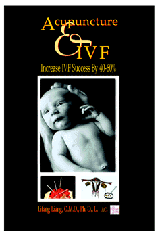We use cookies to make your experience better. To comply with the new e-Privacy directive, we need to ask for your consent to set the cookies. Learn more.
Acupuncture & IVF: Increase IVF Success By 40-60%
Lifang Liang
Blue Poppy Press, 2003
222 pages
Paperback
A 2002 study in Germany demonstrated that performing acupuncture just once prior to and once after embryo transfer in IVF patients increases their chances of becoming pregnant by nearly 50% (see JCM NEWS 69). Now Lifang Liang, a specialist in treating infertility by combining Chinese and Western medicine, has written this comprehensive account of Chinese medicine treatment protocols for patients planning to undergo IVF.
Actually the title of this book is something of a misnomer, and it should more accurately be called 'Chinese Medicine & IVF', for whilst acupuncture protocols are given for all treatment plans, a larger part of the treatment text is devoted to Chinese herbal medicine treatment. It is also unfortunate that the back cover text incorrectly states that the incrased success rate for IVF using only acupuncture is 35%, not 50%, perhaps to dramatise the cover's claim that buying this book will increase success rates by 40-60%.
After short introductory chapters (including the pathology of infertility according to both Chinese and western medicine, and a description of the entire IVF protocol), the bulk of the book is devoted to Chinese medical preparation before IVF for both the female and male partners, and Chinese medicine protocols for the female during IVF. Although the German study mentioned above used a formulaic point combination, here ' as would be expected ' treatment strategies are tailored according to presenting patterns and symptoms.
Fifteen detailed case histories are given, and appendices include a brief research report on acupuncture and IVF and an explanation of western fertility drugs.
For anyone working with infertile women, especially those contemplating or actually undergoing IVF, this book ' the first in its field ' is a must.
Peter Deadman
Contents
Testimonials & Endorsements
Acknowledgements
Preface
Introduction 1.
Overview of Chinese Medicine 2.
The Pathology of Infertility 3.
Procedures of In Vitro Fertilization 4.
Chinese Medical Preparation Before In Vitro Fertilization: Females 5.
Chinese Medical Preparation Before In Vitro Fertilization: Males 6.
Chinese Medical Protocols During In Vitro Fertilization 7.
Prevention of Miscarriage 8.
Case Histories
Appendix 1: Recent Research on Acupuncture & IVF
Appendix 2: Western Fertility Drugs
Appendix 3: Chinese Medicinals
General Index
Formula Index
| Summary | Lifang Liang Blue Poppy Press, 2003 222 pages Paperback |
|---|---|
| Author | Lifang Liang |
| Publication Date | 1 Jan 1970 |
| Number of Pages | 222 |
| Book Format | paperback |
CHAPTER 3
Human in vitro fertilization is a process in which the egg and sperm are fertilized in vitro, meaning outside of the body in a petri dish. (In vitro literally means in glass.) The fertilized embryo is then implanted into the female's uterus. IVF was first successful in the United States in 1981. Since then, it has become a widely accepted method of treatment for infertile couples. There are various causes of infertility, many of which can successfully be treated with IVF. The indications for in vitro fertilization include:
Fallopian tube obstruction
Oligospermia (low sperm count)
Abnormal cervical factor
Immunologic factor'husband or wife
Unexplained infertility
Infertility after tubal surgery
Infertility after treatment for endometriosis
The following is an overview of the steps of IVF:
1. Regulation of hormones
Once pretreatment screening of a couple has taken place, the IVF specialist or team will attempt to regulate and control the hormones prior to beginning IVF. There are many different methods to performing the various steps with in vitro fertilization. Presently, the most common method is for female patients to take oral contraceptive pills for the first month. Recently, there have been some physicians who do not give birth control pills to women over age 40 or if they have high FSH levels. When trying to control ovulation, one common method is for the patient to take leuprolide acetate (Lupron) before or after stopping birth control pills. Another current method is to give ganerel (Antagon) three days prior to the hCG (human chorionic gonadotropin) injection to control ovulation.
2. Stimulation of ovulation
There is a choice of basic stimulation protocols available to the patient and physician. There is no single approach to ovulation stimulation that works equally well for all patients. Physicians will be guided by the person's medical history, and perhaps also by previous responses to those agents, in determining the stimulation protocol best suited for each patient. Even when the woman has normal ovulatory function, ovulation stimulation will be employed in almost all cases in order to induce development of the maximum number of follicles containing mature oocytes. Commonly used drugs, such as menotropins (Pergonal or Repronex), follitropin beta (Follistim), and follitro p i n - a l p h a (Gonal-F), are given to stimulate the ovaries to produce more follicles and regulate the hormones. Pergonal and Repronex contain both the LH (luteinizing hormone) and FSH (follicle-stimulating hormone), while Follistim and Gonal-F contain only FSH.
3. Monitoring follicular development
During the stimulation phase, the ovarian response is usually monitored with some combination of ultrasound examinations to track folicular development and blood tests to measure hormone levels (primarily estrogen and LH). As the follicles mature, these tests may be performed daily over a 4-6 day interval. During the final stages of follicular development and egg maturation, the patient will be given a hCG (human chorionic gonadotropin) injection. This is timed 34-36 hours prior to the egg retrieval, just before ovulation would occur, and helps to change immature eggs into mature or metaphase II eggs.
4. Oocyte retrieval
Various techniques have been used for oocyte aspiration. In the past, laparoscopy was usually employed. This is a procedure that makes small incisions, usually two or three, on the abdomen. Currently, the most common method being used is the transvaginal USG approach. Guided by ultrasound scanning, a physician inserts a long, thin needle through the vagina and into the ovary, thereby emptying the follicles. The needle is connected to a suction pump and the fluid from each accessible follicle within the ovary is aspirated. Not all the eggs retrieved will be mature or normal in appearance. The percentage of eggs achieving fertilization depends on many factors. Some eggs that appear to be mature and normal in appearance will not become fertilized even when exposed to normal sperm. Not all eggs exposed to sperm will go on to division (cleavage). Not all eggs fertilize and even those that do may not all continue to divide beyond the four cell stage. As an example, a typical cycle may produce twelve eggs of which eight become fertilized and seven begin to divide in a satisfactory fashion. Depending on the female patient's age, 2-4 will be transferred to the uterus and two or three will be cryopreserved (frozen).
5. Laboratory component
If the follicle is mature, a visible amount of granulosa cells will accompany the aspirated fluid in which the mature ovum is found. This fluid is examined by an embryologist under a microscope in order to identify and isolate the egg complex. The oocyte is identified and graded for its maturity, placed in an incubation medium within a petri dish, and finally transferred into the incubator. Eggs are usually cultured in the incubator for 3-6 hours depending on maturity before being exposed to sperm .
For semen, various forms of preparation can be used, from a simple washing and centrifugation, to a more complicated "swim-up" procedure that separates only motile sperm to be used for insemination. To perform insemination, between 50,000-500,000 motile sperm per milliliter are needed. When sperm quality and/or numbers are low, it may be necessary to hold the egg under the microscope and inject a single sperm into the interior of the egg (a procedure known as intracytoplasmic sperm injection or ICSI).
6. Embryo growth in culture
Once the oocyte has been fertilized with the sperm, it is examined approximately 15-18 hours later for fertilization and switched from the incubation medium to a growth medium that contains twice the amount of protein. Next, the fertilized egg is returned to the incubator and kept there until the time of transfer, usually around 48-72 hours after insemination. The fertilized egg is ordinarily in the four or eight-cell stage before transfer of the embryo can take place.
7. Embryo transfer
Approximately 2-6 days after insemination, the dividing embryos selected for replacement in the uterus are loaded into a soft plastic catheter. Using a small volume of medium, the biologist loads the catheter and the physician passes it through the cervix wall into the uterine cavity. Most programs transfer 2-3 embryos in patients under age 35 undergoing their first cycle of treatment, and 3-4 in those ages 35-40 to maximize their chance of success while minimizing multiple pregnancies. Additional healthy embryos may be frozen in liquid nitrogen to be used later if implantation and pregnancy do not occur.
8. Luteal phase monitoring
After ovulation has occurred, supplemental progesterone in the form of vaginal suppositories, injections, or micronized oral tablets may be added. Ultrasonography may be employed to measure ovarian size, particularly if hyperstimulation is suspected.
Pregnancy testing is usually performed 12-14 days after egg retrieval. If the results are positive, progesterone levels will be checked and the pregnancy test repeated in order to measure the rate of rise in hCG that occurs in early pregnancy. Using vaginal ultrasonography, a fetal sac typically can be seen 25 days following egg retrieval, and by the 35th day, fetal heart motion can be observed.
* Orders shipped outside of Europe are eligible for VAT relief and will not be charged VAT.




